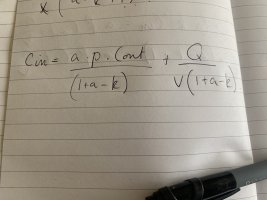If I wanted to find the value of Cin for the following equation:
Cin = a P Cout – (a – k) Cin + Q / V
Where Cin and Cout are the indoor and outdoor concentrations and the other parameters are as follows;
Cout = 15
P = 1
a = 1.2
k = 1.19
Q = 1.4
V = 2.5
How would I rearrange the equation to get the value of Cin?
Cin = a P Cout – (a – k) Cin + Q / V
Where Cin and Cout are the indoor and outdoor concentrations and the other parameters are as follows;
Cout = 15
P = 1
a = 1.2
k = 1.19
Q = 1.4
V = 2.5
How would I rearrange the equation to get the value of Cin?

